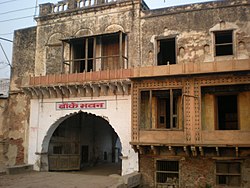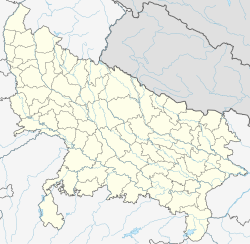Top Qs
Timeline
Chat
Perspective
Hathras
City in Uttar Pradesh, India From Wikipedia, the free encyclopedia
Remove ads
Hathras (Hindi pronunciation: [ɦaːt̪ʰ.ɾəs]) is a historical city in Uttar Pradesh, India. It is the headquarters of Hathras district, formed on 3 May 1997 by merging parts of Aligarh, Mathura and Agra. It is part of the Aligarh Division.[3]
This article needs additional citations for verification. (January 2019) |
The primary spoken language is a dialect of Hindi, Braj Bhasha, which is closely related to Khariboli, one of several dialects spoken in the Delhi region.[4] It is known for production of asafoetida.[5]
Remove ads
History
At the end of the 18th century, the town of Hathras was held by a Jat chieftain, whose fort stood at the east end of the town, and was annexed by the British in 1803, who besieged the fort in 1817. Under British rule, Hathras rapidly rose to commercial importance, and for a while ranked second to Cawnpore (now Kanpur) among the trading centres of the Doab.[6]
Hathras became a district on 6 May 1997 with the merging of some talukas of Aligarh and Mathura.[7] Hathras falls under the Braj region of Northern India and is famous for its industrial, literary, and cultural activities. It has been an industrial centre since the British ruled India.
Remove ads
Administration
Hathras is the headquarters of the Hathras district. The Hathras district, formerly known as Mahamaya Nagar, was created in 1997 with the incorporation of parts of the Aligarh, Mathura and Agra districts.
The Hathras district has four subdivisions: Hathras, Sasni, Sikandra Rao, and Sadabad. The Hathras Lok Sabha constituency is reserved as a Schedule Caste seat. The district has three assembly constituencies.[8]
The Hathras Assembly constituency has nine local bodies:[9] Hathras, Sikandra Rao, Sasni, Sadabad, Mursan, Hasayan, Sahpau, Mendu, and Purdil Nagar.[10]
Remove ads
Geography
Hathras is located at 27.6°N 78.05°E.[11] It has an average elevation of 185 metres (606 feet) and is situated on the Agra, Aligarh and Mathura, and Bareilly highway crossings. It is known for its extreme temperature variations.[12] As of the 2001 Indian census, Hathras had a population of 123,243, of which 53% were male and 47% female. Hathras has an average literacy rate of 60%, higher than the national average of 59.5%, of which 66% being male and 53% being female. 14% of the population is under six years of age.
Climate
Hathras has a monsoon-influenced humid subtropical climate, typical of north-central India. Summers start in April ending around May. The monsoon season starts in late June, continuing until early October, bringing high humidity.[13]
Remove ads
Transport
Hathras is served by four railway stations: Hathras Junction railway station, Hathras Road railway station,[16] Hathras City railway station, and Hathras Kila railway station. A new station on the dedicated Eastern Dedicated Freight Corridor was named New Hathras.
Notable people
- Kaka Hathrasi, poet
- Raja Mahendra Pratap, king of Mursan Riyasat [17]
- Thakur Malkhan Singh, freedom fighter[18]
- Ramveer Upadhyay, former Cabinet Minister of Uttar Pradesh
References
External links
Wikiwand - on
Seamless Wikipedia browsing. On steroids.
Remove ads



